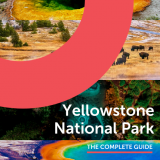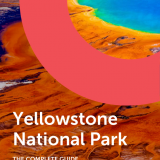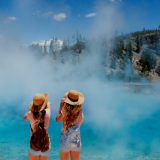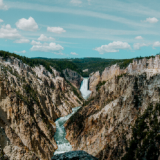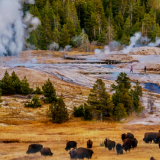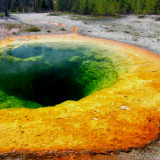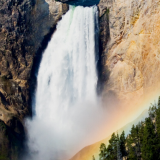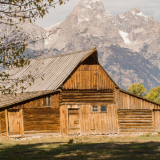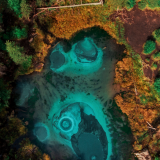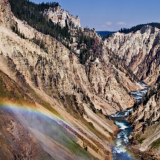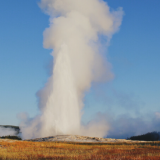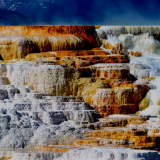Spread over three states and covering a hiking-boot-battering 2.2 million acres, Yellowstone National Park is one of the most iconic national parks in all of America. Clichés aside, it’s the stuff of superlatives. It was the first of the designated national parks in the USA. It lays claim to 60% of the planet’s natural geysers. It’s 30 miles north of Grand Teton National Park. Oh, and it’s all set atop the largest supervolcano this side of Indonesia – just to put your nerves at ease.
Now a UNESCO World Heritage Site, Yellowstone has been at the heart of American conservation and preservation efforts since the late 1800s. The protected reserve encompasses countless biomes and habitats. It’s hemmed in by high peaks, from the blustery Beartooth Mountains in the north to the jagged Tetons to the south. Between those come wild rivers, steaming springs, and dense forests. The result is a hive of wildlife, but also a playground for outdoorsy types channeling the spirit of the pioneers.
Where is Yellowstone National Park?

Yellowstone officially dips into three states. However, the vast majority of the reserve – more than 95%, in fact – is in Wyoming. Some beautiful sections of the wiggling Yellowstone River await travelers in Montana, while alpine meadows and vistas of the great Teton ranges beckon in the small part of the park that’s over in Idaho. More generally, Yellowstone National Park straddles the Continental Divide right in the heart of the Rocky Mountains – it’s around 1,000km from the West Coast and 1,800km from the Great Lakes.
Yellowstone National Park Facts

Yellowstone wasn’t just the first national park to be established in the United States. It was actually the first on the whole planet. Signed into law by President Ulysses S. Grant in 1872, it’s credited with bringing the preservation and conservation movements together in one of the first acts of natural land protection anywhere on Earth.
Another mind-boggling factoid about this enthralling corner of the US is that it hosts over 10,000 geothermal sites, 500 of which are active geysers! It also includes more than 290 waterfalls and experiences a rather disconcerting 1,000+ earthquakes every year. Yikes!
Best Time to Visit Yellowstone

Most people will head to Yellowstone National Park during the summer months. Between June and August, the weather tends to be balmy, with temperatures peaking in the 70s and 80s. There’s lots of sun, but days are often punctuated by dramatic electrical storms. Insects can also be an issue.
If you’re keen to ditch the crowds, you could consider a trip to the park in spring or autumn. We’d recommend months like May and September to catch the best of those. The closer we get to winter in Yellowstone National Park, the more unpredictable things become. In fact, this high up (Yellowstone has an average elevation of 7,800 feet!), torrential rainstorms and blizzards can take over in the blink of an eye, regardless of the seasons.
Yellowstone National Park Hours

Officially, Yellowstone National Park is open 24 hours a day, all year round. However, the reality is a little different than that. Adverse weather conditions – AKA snow – keep pretty much all of the internal roads shut throughout the winter. The main lodges and campsites typically wait for the thaw in late April to get going again. They close around mid-October again, but a select few also open for the winter months. Thankfully, the official NPS website maintains updated lists of what entrances and exits are open at any given moment so you can better plan your next Yellowstone visit. Yellowstone National Park is under limited operations due to COVID-19. Some facilities may not be available and staffing may be limited.
Yellowstone National Park Entrance Fee

You will have to fork out a few dollars to see the splendor of Yellowstone National Park. Non-commercial vehicles can grab a seven-day pass for $35 (motorbikes go for just $30). If you’re arriving on foot or by bicycle (kudos!), it’s just $20 for the week. It’s also possible to score an annual pass – that’s $70 for the car and three passengers. The good news? Up to 80% of the entrance fee goes into critical projects within Yellowstone itself.
Visiting Yellowstone

You can approach Yellowstone National Park from all four compass directions. Be warned: It’s pretty remote. Most will choose to fly and then rent a car. The skier’s favorite of Jackson Hole Airport sits within the Grand Teton National Park, which is actually contiguous with Yellowstone National Park – the two are linked by Highway 191. The Yellowstone Regional Airport is in nearby Cody (a town founded by Buffalo Bill, believe it or not). The car hire booths there are about 30 minutes’ drive from the East Entrance. Interstates 90 and 15 run rough rings around the reserve too, offering road access via Idaho and Montana.
Yellowstone National Park Lodging

Yellowstone Airbnb
Airbnb rentals are prohibited within the borders of the Yellowstone National Park. But that doesn’t mean you can’t find some real doozies of digs just on the outskirts. Down in Jackson, there are hearty Wyoming mountain lodges up for grabs, complete with log-timber walls and roaring fires. Cabins hidden between pockets of Engelmann spruce trees sit on the Idaho side of the border. Meanwhile, Watipi is a hotspot for rentals near the East Entrance. Staying there puts you in a real Wild West landscape, amid canyons and cattle ranches.
Yellowstone Hotels and Hostels
If camping isn’t your thing, there are plenty of hotels, hostels, inns, cabins and B&Bs within a quick drive of Yellowstone. Here are some of our favorites:
- Bill Cody Ranch
- The White Buffalo Club
- Spring Creek Ranch
- Jackson Lake Lodge
- Silver Gate Lodging
- Legacy West
- Teton Hostel HideAway
- Bentwood Inn
- Shepherd Family Retreats
- Blackwater Creek Ranch
Yellowstone Camping
Planning a night under the stars? Here are some of the best campgrounds and campsites inside and outside of Yellowstone National Park:
- Grant Village Campground
- Madison Campground
- Bridge Bay Campground
- Canyon Campground
- Norris Campground
- Tower Fall Campground
- Slough Creek Campground
- Lewis Lake Campground
- Pebble Creek Campground
- Indian Creek Campground
Yellowstone Tours
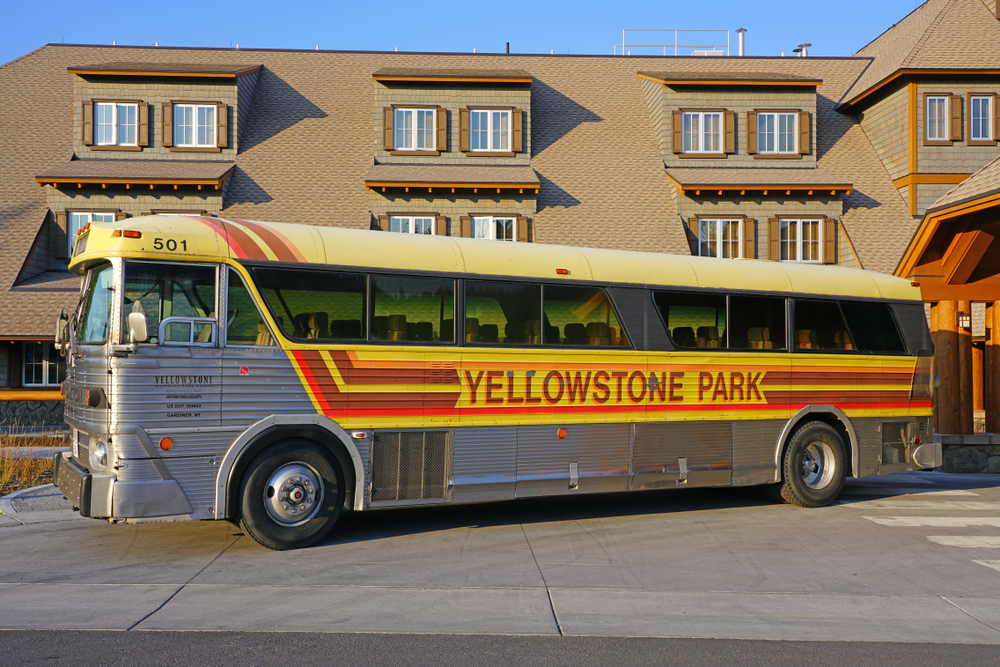
Choosing to join a guided tour at Yellowstone National Park can be a great way to dodge the stress of planning your own adventure. The good news is that there are more itineraries on the menu than you can blow a bubbling volcanic geyser at. Popular packages usually include stops at the iconic Old Faithful geyser and a wildlife drive around the Lower Loop – bears, bison and elk are all common sightings. More unusual tours could involve anything from gnarlly snow trucks during the winter to scenic blow-up boats down the easy rapids of the Yellowstone River. Due to the number of guided tours, Yellowstone National Park is a great national park for beginners!
Yellowstone Landmarks
Old Faithful

Of all the hundreds of geysers that spurt from the ground in Yellowstone National Park, there’s none as famous as Old Faithful. It was the first geothermal landmark in the region to be named, and its moniker reflects the fact that it loyally erupts at least 20 times each day. Seeing one of the great spurts of water is one of the true joys of a visit to the park. They have been known to throw steaming H2O more than 56 meters in the air and can last a whopping five minutes from start to finish.
Mammoth Hot Springs

Just in case you needed a reminder that Yellowstone National Park sits right on top of an active volcano, check the Mammoth Hot Springs on the main N Entrance Road south of the Montana gate. They spread across a large plinth of travertine, forever broiling and steaming. Over the centuries, large whitewashed mineral deposits have also built up there, forging a strange and alien landscape. Thankfully, a hiking trail weaves through the whole area and offers some excellent viewing platforms along the way.
Lower Falls

The jaw will surely drop when you first see the grand Lower Falls. They are like Wyoming’s answer to Niagara, roaring over the carved red-rock cliffs to the gurgling Yellowstone River below. In total, they clock up a height of 308 feet at their tallest point and reign as the largest cataract in the whole of the Rocky Mountains. They are at their mightiest just after the spring thaw but also look awesome in winter, framed by huge pillows of snow and ice.
Yellowstone Hiking
In Yellowstone, skies are blue and beautiful hikes are plentiful. If you’re ready to stretch your legs (but not sure where to start), here’s a list of 10 of our favorite hiking trails in Yellowstone National Park:
- Lone Star Geyser Trail
- North Rim Trail
- Avalanche Peak
- Mystic Falls Trail
- Trout Lake Trail
- Uncle Tom’s Trail
- Elephant Back Mountain Trail
- Mount Washburn Trail
- Storm Point Loop Trail
- Electric Peak Trail
Things to Do in Yellowstone
Snap an Insta pic at Grand Prismatic Spring

Stand on the edge at Lower Falls

Go on an American safari in the Lamar Valley

Hike along the rugged Grand Canyon of the Yellowstone

Watch bison in Hayden Valley

Stare into the mysterious Morning Glory Pool

Take a boat out on Yellowstone Lake

Marvel at Norris Geyser Basin

Go geyser hunting at Old Faithful

Walk along the boardwalk at Mammoth Hot Springs

